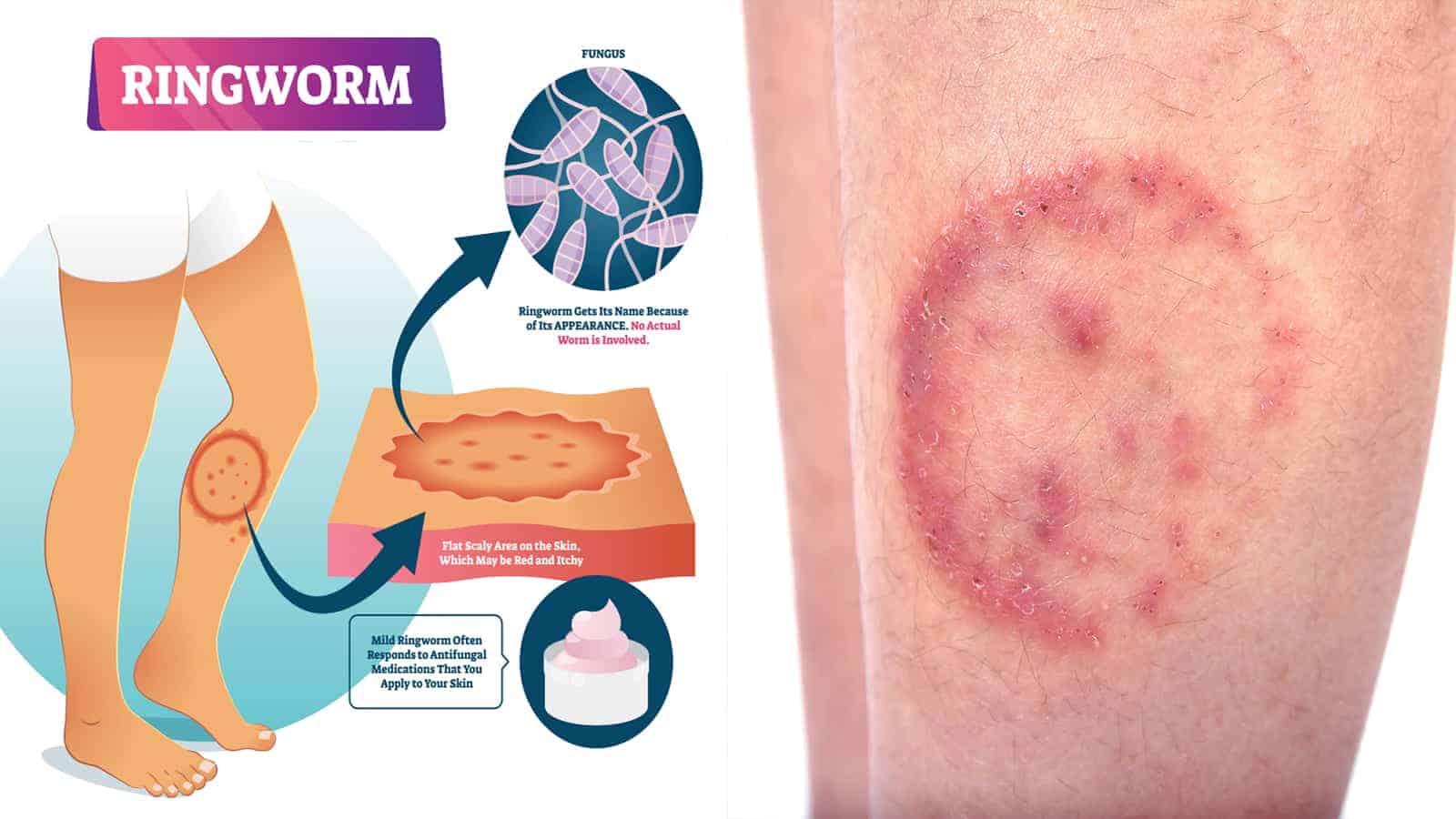Ringworm is an uncomfortable, itchy rash that appears on your skin. While it is a common and well-known occurrence, not everyone understands the details of it. Learning more about the symptoms, what can cause it, and the ringworm treatments can help you identify and heal it quickly.
Ringworm, caused by a fungal infection, can occur in any part of your body. It is typically a circular rash, with red around the edges and clear in the middle. This fungal infection occurs due to mold-like fungi on dead skin, hair, and nail tissues.
Many people think this skin infection has something to do with a worm because of its name, but that isn’t the case. Its name comes from the red work-like ring that appears on your skin. The condition is similar to athlete’s foot and jock itch, too.
This condition is highly contagious but can be treated easily in most cases. However, you will want to recognize the issue quickly and get treatment right away. Plus, knowing what can cause it can help you avoid catching the infection later on.
Signs and Symptoms of Ringworm
Recognizing the symptoms of ringworm can help you avoid catching it from others. Plus, you’ll know when to avoid going around other people to prevent spreading it to them. The telltale sign is a red, ring-shaped rash, but there are other things to watch for.The ring shape typically appears on the buttocks, trunk, arms, or legs. However, before the ring develops, you might notice a scaly patch or itchy bump on your skin. Then, once the circle appears, it could appear as multiple circle-shapes.
The inside of the ring is typically clear and scaly but lighter in color. Sometimes, the center will be dotted with red bumps and itch excessively. You might also notice that the ring is bumpy or slightly raised, and sometimes it won’t appear at all.
If the skin infection occurs on your scalp, it’ll start as a small sore or bump. Then, it’ll turn scaly, and the skin might begin to flake. It’ll feel sore and tender when you touch it, and your hair might fall out in that area.
Many people are surprised to learn that this skin infection can occur on your nails, too. It can happen on your fingernails or toenails, causing your nails to become thick and discolored. Additionally, an infection on your nails can cause them to become extremely brittle.
This skin infection might cause your skin to peel or crack. Plus, along with itching, it can also cause a stinging or burning sensation. Whether you experience all of the symptoms or just a few, the situation is uncomfortable.
Ringworm Causes
As a highly contagious fungal infection, this condition is caused by mold-like parasites that live on cells. The parasites live on cells in the outer layer of your skin and can spread in a few different ways, including:
- Direct contact with an infected person
- Touching an animal with the infection, as it commonly affects dogs, cats, and cows
- Direct contact with a contaminated surface or object, such as clothing, towels, or bedding
- Prolonged contact to infected soil
The fungi that can cause the infection grows out of control in warm, moist environments. When it grows out of control, you’ll begin to notice the symptoms, and it becomes contagious. It’s commonly spread in public showers, locker rooms, and pool areas because it’s the perfect environment to grow.
Additionally, the infection spreads during close-contact sports. People who participate in wrestling commonly develop it because of the constant physical contact. Not only is the gym hot and humid, but the fungi transfer to many people and surfaces.
Another cause of the infection is wearing tight or restrictive clothing because it gives the fungi a place to grow. If your skin or the clothing becomes damp, it’s the perfect environment for the infection to develop. The clothes will rub your skin, creating small tears, and then it’ll hold any moisture in the tight space.
Likewise, wearing shoes that are too tight can also cause skin infection. Shoes that are too small can cause excessive sweating, making the inside of your footwear moist and humid.
Risk Factors
Some health conditions make it more likely to develop symptoms from the infection. People with diabetes, obesity, or immune systems problems have an increased risk. Plus, anyone with a minor skin injury is more likely to develop the infection than those without one.
People that live in a warm climate are more likely to develop the infection than others. When the temperature is consistently warm and humid, the fungi thrive and continue growing.
Children are more likely to get a skin infection, but it can affect people of all ages. The more items you share with others, the more likely you are to pick up the fungi.
Additionally, people that have frequent contact with animals have a higher risk of developing skin infections. You can always see the condition on an animal’s skin because the fur can cover it. So, you might come into contact without realizing it.
Diagnosis and Treatments
If your skin condition doesn’t improve within two weeks, you might need to see your doctor for treating ringworm. Typically, your doctor can diagnose the infection on sight, or they’ll examine scrapings for a diagnosis. Before seeing your doctor, you can try to clear up the affected area at home.
Over-the-counter treatments can help with fungal infections, which is typically what your doctor will suggest. The treatments come in the forms of lotion, cream, and ointment, and you apply them directly to the area. Once you use these treatment options, you’re likely to experience relief quickly.
However, you’ll want to continue using the treatment for two to four weeks, depending on the instructions. You’ll need to use it for full time, even if it appears to go away, to ensure it kills the fungus. Killing it ensures that the infection doesn’t return once you stop the treatment.
Make sure to clean the affected area before applying treatment, and keep it dry at all times. You’ll want to wash your hands each time you touch the area before touching anyone or anything else. Additionally, wash any clothing, bedding, or towels that you used.
If the infection is on your nails or scalp, you might need a prescription for an oral medication. It’s not as easy to keep those areas clean and keep creams or ointment on them. There are also antifungal shampoos for infections on your scalp.
Preventing Ringworm
This skin infection is difficult to prevent because the fungus is common and contagious before symptoms appear. However, you can take steps to prevent it. Start by educating yourself and those around you.
Make sure people know how it spreads and what to watch for. Plus, letting people know that you can catch it from pets can help, too. Encourage people to wash their hands after touching their pet, even if there don’t appear to be any issues.
You should also wash your hands often, even if you don’t think you touched anything that’s been contaminated. If you share items with others, sanitize the surfaces between uses. Plus, keep any shared areas clean and sanitized, and avoid sharing things that you don’t have to.
If you participate in contact sports, make sure to shower right after playing. Keep your gear and uniform clean, and wash it even when it doesn’t appear dirty. Avoid sharing your sports gear with other players, too, as direct skin contact can spread the infection.
Anytime you use a public shower or locker room, wear flip-flops and avoid going barefoot. These areas tend to be humid, making them the perfect environment for fungi growth.
Other ways to prevent the infection include wearing clean clothing that fits well. Avoid anything too tight, including your shoes. Shoes should fit in a way that allows air to circulate around your feet.
Keep your fingernails and toenails short to avoid getting fungi beneath them. Make sure to keep your nails clean, too.
The best way to prevent skin infection is by avoiding people and animals that you know are infected. If you see that they have a patch of skin that looks strange, avoid coming into contact with them. Don’t share items, clothing, or towels with someone who has an infection, either.
Final Thoughts on Ringworm Symptoms, Causes, and Treatments Never to Ignore
Ringworm is a common skin infection, and it is highly contagious. It’s uncomfortable and itchy, so you’ll want to treat it as soon as it develops. Knowing the symptoms and sources can help you get it under control right away.
Plus, knowing what can cause the skin infection can help you prevent it, too. If you know what to look for, you’ll learn not to come in contact with an infected person or animal. You’ll also know what steps to take to ensure a clean environment that is free of fungus.
Remember this information about ringworm, and share it with those around you. The more people that know, the easier it is to reduce the spread of skin infection.

















 Community
Community

